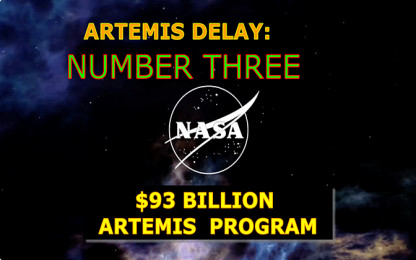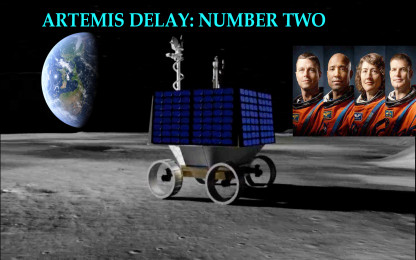Advertisement
Artemis Delay: Number One
UPDATE: Artemis Delay number one:
https://153news.net/watch_video.php?v=43YOO6GW97YY
Artemis Delay number two:
https://153news.net/watch_video.php?v=4UMND3H59HO7
Artemis Delay number three:
https://153news.net/watch_video.php?v=8S9A7675A29X
I expect many more, and nothing but delays, to come. so, I’ve decided to number them.
The delays are far more complicated than exploding vehicles and involve problems far harder to solve.
NASA, a permanent black hole for billions of dollars.
NASA Administrator Bill Nelson announced that Artemis 2, the first crewed mission that will send four astronauts around the moon, had been pushed back from the end of 2024 to no earlier than September 2025. Artemis 3, the first crewed landing, was in turn delayed from late 2025 to no earlier than September 2026.
- Category: NASA / ISS /Mars/ Moon Landing,Space Toys
- Duration: 08:52
- Date: 2024-01-10 14:06:38
- Tags: nasa
8 Comments
Video Transcript:
This week NASA named four astronauts who have the right stuff. Their mission returned to the moon 50 years after the Apollo flight ended. The crew includes the first woman and first black astronaut on a lunar mission. Wait a minute. I thought you said we never went to the moon and now they claim to be returning. No, we never went to the moon. And neither is this group. Are you one of those conspiracy nuts that I've heard about on the news? I'm one of those guys who investigate Sothers claims. To see if they stand up to what they claim. The TV says that's what nutty people do. Well, then I'm just going to have to be a conspiracy nut. Let's take a look at this news story about NASA's. Return to the moon. Ladies and gentlemen, your Artemis 2 crew. NASA's deep space hopes will rocket with this crew. To the moon, to Mars, and beyond. But first, let's take a look at some interesting information that seems to contradict. What we've been told about Apollo's many trips to the moon. Okay. But I haven't seen anything yet. That causes me to doubt NASA's story. Orion is getting ready to launch. My name is Kelly Smith and I work on navigation and guidance for Orion. Orion is NASA's next generation spacecraft. Built with versatility in mind, it can take astronauts deeper into space than we've ever gone before. To an asteroid or even onto Mars. For these missions, Orion has to be one tough spacecraft, with standing high speeds, searing temperatures, and extreme radiation. Before we can send astronauts into space on Orion, we have to test all of its systems. And there's only one way to know if we got it right. No astronauts will be able to. The spacecraft is loaded with sensors to record and measure all aspects of the flight in every detail. It all begins with launch. A board of Delta 4 has the spacecraft and the upper stage begin their first lap around Earth. Mission control in Houston is monitoring the progress of the flight. Orion is over 100 miles up and going about 17,000 miles per hour. Just as it passes over the Indian Ocean, we lose communication. As we get further away from Earth, we'll pass through the Van Allen Bells, an area of dangerous radiation. The Van Allen Bells start at 1,000 miles above the Earth, and reach out as far as 25,000 miles. Radiation like this can harm the guidance systems, onboard computers, or other electronics on Orion. Naturally, we have to pass through these dangers on twice, once up, and once back. But here comes the part that doesn't make sense. But Orion has protection. Shielding will be put to the test as the vehicle cussed through the waves of radiation. Sensors aboard will record radiation levels for scientists to study. We must solve these challenges before we send people through this region of space. What he just said, throws a monkey wrench into NASA's story, about the Apollo missions. Is it starting to get a bit clearer to you? I don't see how they could have gone to the moon before they solve the radiation problem. That's like putting the card before the horse. Let's see if this story gets any more doubtful. Okay. Let's take one last look at a bit more contradictory information before we come to any conclusion. This is from my video, Wagon the Moon Doggie. Which is based on the great work of author Dave McGowan. One thing they'd like to talk a lot about is the Van Allen radiation belts. The moon hopesites talk a lot about them as well. The hopeters will tell you that man cannot pass through the belts without a considerable amount of radiation protection. Protection that could not have been provided in the 1960s through any known technology. And the debunkers claim that the Apollo astronauts would have passed right through the belts quickly enough that given the levels of radiation, no harm would have come to them. The hoaxers say debunkers are just being verly men. As it turns out both sides are wrong, the debunkers shockingly enough are completely full of shit. And the hoaxers have actually understated the problem by focusing exclusively on the belts. We know this because NASA itself, whoom bit debunkers like to treat as virtually unimpeachable source on all things Apollo, except apparently when the agency posts an article that implicitly acknowledges that we haven't actually been to the moon, as told us that it is so. They have told us that in order to leave low Earth orbit on any future space flights our astronauts would need to be protected throughout the entirety of the flight, as well as, and once again, this comes directly from NASA while working on the surface of the moon. On June 24, 2005 NASA made this rather remarkable admission, quote, NASA's vision for space exploration calls for a return to the moon as preparation for even longer journeys to Mars and beyond. But there's a potential showstopper, radiation. Space beyond low Earth orbit is a wash with intense radiation from the sun, and deep galactic sources such as supernovas. Back in the 1960s of course we didn't let a little thing like space radiation get in the way of us beating the russkes to the moon. But now I guess, being that we're more cultured and sophisticated, we want to do it the right way so we need to come up with a way of shielding our spaceships, and our temporary moon bases, and figure out how to do that according to NASA, could be a real, quote, showstopper. As NASA notes the most common way to deal with radiation is simply to physically block it, as the thick concrete around a nuclear reactor does, but making spaceships from concrete is not an option. Lead, which is considerably denser than concrete, is actually the preferred material to use for radiation shielding, but lead also isn't very popular with space ship design. In fact, world on the street is that one of the main reasons the Soviets never made it to the moon was because their scientists calculated that four feet of lead shielding would be required to protect their astronauts, and those same scientists apparently felt that spaceships wouldn't fly all that well. When clad would four feet of lead. Now NASA. So, what do you think? Are you convinced NASA has been lying? It sure doesn't look good. Why don't we wait to see if they actually make an attempt to go around the moon with Artemis 2? My guess is that it'll be all talk and no action. As it has been for the last 50 years. Okay, fair enough, we'll wait and see. The NASA is also facing delays to its lunar mission aiming to return astronauts to the moon this decade. Ian Geon has a details. Meanwhile, NASA announced during a news conference on Tuesday that its Artemis program, which aims to return astronauts to the moon this decade, is facing some lengthy delays. The Artemis 3 mission to land humans on the moon for the first time since the Apollo program was previously set to complete this milestone by 2025. But it is now expected to not happen until at least September 2026. The space agency said that the primary reason for the delay includes two failed test flights in 2023. The tests in 2023 of Starship, which is the spacecraft that is expected to take astronauts from lunar orbits to the moon's south pole, both ended in explosions. What an astounding coincidence. Certainly, no one could have seen this coming. Let's call this report. Artemis Delay. Number 1. The Earth's Earth. The Earth's Earth. The Earth's Earth. The Earth's Earth. The Earth's Earth. The Earth's Earth. The Earth's Earth. The Earth's Earth. The Earth's Earth. The Earth's Earth.










 Donate
Donate







